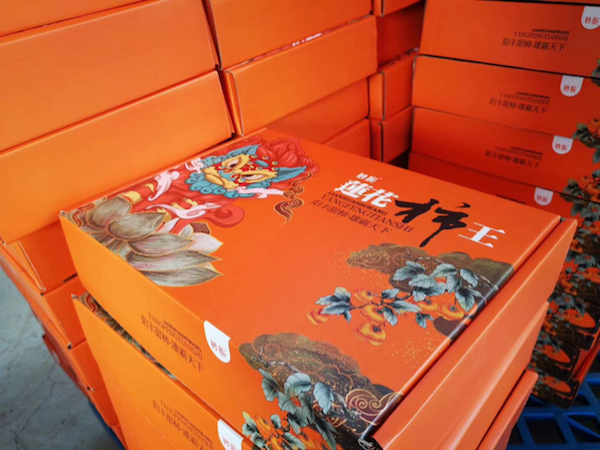The sweet persimmon is a small fruit that has unique East Asian characteristics. The bitter taste disappears as soon as the persimmon ripens. They are harvested when sweet and immediately ready-to-eat.
The sweet persimmon has a beautiful color and luster, and a fresh flavor. This fruit is also full of nutrients and better for your health than the regular persimmon. That is why the sweet persimmon has great commercial value and occupies a strong competitive position in the Chinese fruit market. The fruit grows quickly and ripens early. Furthermore, the harvest is plentiful, the production cost is low, and the profit margin is big. Yet in China almost all persimmon farmers cultivate the regular, bitter persimmon. The overall surface area devoted to sweet persimmon plantation only accounts for 2%.

Sweet persimmon

Sweet persimmon
Although the sweet persimmon industry has slowly been growing for years, every year the market demand far exceeds market supply. The main reason is that most farmers produce bitter persimmon instead of sweet persimmon, which in turn is because Chinese consumers are not that familiar with the sweet persimmon and most farmers choose the safe option.
Second, although the sweet persimmon is harder than the regular persimmon, the sweet persimmon can still only be kept fresh for 7-10 days. The fresh persimmon does not survive well in storage, during packaging, or in transport. Third, the sweet persimmons are mostly sold in retail rather than wholesale. The price fluctuations in this market are frequent and high.

Sweet persimmon

Sweet persimmon
One of the most stable sweet persimmon varieties is the Yangfeng sweet persimmon. "The Yangfeng sweet persimmon usually enters the market in October and the supply season continues until late November.
The fruit bearing ratio of Yangfeng sweet persimmon is higher than other sweet persimmon varieties, and this variety does not require cross-pollination. The Yangfeng sweet persimmon trees reach their productive phase in the second year and their most productive phase after four years.
All our Yangfeng sweet persimmon are harvested when they are 'naturally ripe', which is around 90% ripe. Only then do we take them from the trees. That is nearly half a month later than most other sweet persimmon plantations, but we are better able to control the product quality of our sweet persimmon in this way. That is how we guarantee the best flavor for our sweet persimmon." This is according to Ms. Tian Yingzhen of Xia County Xiale Agricultural Science and Technology Co., Ltd.

Sweet persimmon

Sweet persimmon
"We sell our Yangfeng sweet persimmon under our own brand 'Miao Cui'. We sell most of them via e-commerce platforms to consumers throughout the country. We also sell a small volume of sweet persimmon via traditional retail channels.
"We package our sweet persimmon in 2.5 kg boxes, which contain 12 large sweet persimmon or 18 medium sweet persimmon. We only have a supply season of roughly one month per year, but the sales conditions are great. According to market feedback, Chinese consumers are becoming more aware of sweet persimmon, and they love this fruit."
For more information:
Ms. Tian Yingzhen
Xia County Xiale Agricultural Science and Technology Co., Ltd.
Tel.: +86 135 0359 5116
E-mail: [email protected]
